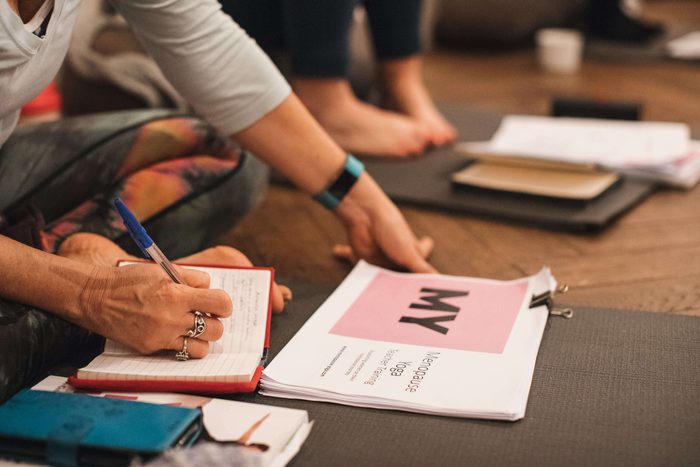It’s 2023, why are we still talking about Low Back Pain?
It might seem like old hat, but it’s a huge issue. Around 80% of us will have an episode in our lives, 20% of adults have ongoing pain, and initial studies suggest that the pandemic will only have caused this number to increase. A quick internet search will show how widespread the problem is and how varied the possible solutions are.
As an Osteopath, back pain specialist and Yoga for BackCare teacher, a fair amount of my time is spent with students & patients with LBP, and I know how much it can get in the way of living a full life. The spine is such a foundational part of our human body – it houses our nervous system, moves us around and helps us interact with the world. When things go wrong (and sometimes even a minor muscle spasm can do it), our ability to do what matters is challenged.
Even as yogis and yoga teachers, we are not immune, and over the years I have seen that yoga can also cause or exacerbate LBP. I’ve been thinking about why…
Why do Yogis end up in my clinic - doesn’t Yoga help back pain?
There has been great research evidence from the UK, India & the US showing that certain Yoga practices, practiced regularly, can have a positive impact on back pain – reducing pain, disability, workplace absence, medication use and more – this led to the NHS’s NICE guidelines including ‘mind-body group exercise’ in their back pain guidelines (NG59 LBP). NICE’s inclusion back in 2016 allowed me to set up an NHS-based LBP programme using yoga methods for patients.
BUT, yoga can also cause grumbles in the low back – and on occasion injury and pain as well. Why is this, and how can you make your practice (and teaching) safer?
In my experience, 3 broad factors lead to LB injuries on the yoga mat:
- Inappropriate class style or level
- A lack of understanding of what the posture is about & how it works
- Inattention when on the mat
Generally, these can be summed up by a lack of awareness & truthfulness in the practitioner BEFORE they practice: if we don’t know our own body type, or aren’t paying attention to our stamina level or even how we feel on that day, there is always the possibility of the yoga practice doing more harm than good.
1. Inappropriate class style or level
We’ve all done it – taking a heavy Level 2 class when we are tired to ‘perk ourselves up’, rather than a nourishing Restorative. As teachers, many of us have seen it – a complete beginner turning up at a 75m vinyasa practice. And what about body type – does this matter? If you are super-flexible, do you need more flexibility or in fact more strength? (this is a whole newsletter in its own right!). In essence, putting our bodies through a class that isn’t right (right style, right time, right level, right frequency) is a good way to risk injury.
2. Lack of understanding about the posture
Some styles of Yoga are great at explaining why we are doing what we are doing. Others less so – this might be because it’s a fast-paced class, or that the students just want to move and not think. But if you don’t know why you are doing an asana – the intention - how can you do it properly? I’ve seen lots of injuries from twists & standing postures, done quickly and without understanding of WHAT the posture is for. Yoga isn’t just about shapes, and we have to know what bit we should be moving. Asana should be a system of improving health through systematic sequencing. Warm up moves are there for a reason and so is teaching ‘proper’ alignment.
3. Inattention when on the mat
Now this is a big one, and it ranges from your mind wandering off when you’re in a standing pose, to struggling to keep up with a fast class. And it’s also linked to point 2 – for example, if you don’t know ‘why’ you are doing a posture, how can know if that feeling in your body is just ’trying hard’ or actually asking your body to do something it shouldn’t? When we aren’t paying attention, accidents can happen – you can tweak a muscle, sprain a joint or worse.
4. Sorry, there's a late entrant for sneaky number 4: not enough rest
One thing I see as a common factor in my clinic and classes is how busy we all are, and the last 2 years have made life more stressful. The body has a natural tendency to find health, but it can only do this if we make time to rest and recuperate.
Don’t neglect Savasana – it’s one of the most important postures in your practice. It allows the body to adjust to all the other changes we have made, to process, for the nervous system to ‘reset’ and to just ‘be’. Proper rest is of primary importance for back health – and thankfully Yoga-based practices have many ways to help. Savasana EVERY SINGLE DAY, just for 10 minutes, whether or not you have ‘done’ a class!
And within those 1-4, remember that certain postures or practices can be more or less troublesome for some people. As Paul Grilley says in his book Yin Yoga, “Not every posture is suitable for every body”.
So how can we help our backs through yoga? Well, think about the points above and notice what resonates. Refresh your knowledge by watching an anatomy video online – review how the spine moves, how it works and how it might get injured. Once we have that understanding, then we are able to practice with increased awareness of what the asana or posture is doing – in the general sense and also in OUR body at that moment.
Yoga can really help LBP, and also irritate the back – so take the time to learn about your body and how Yoga can become a support to your spinal health.
Join Anji for her upcoming 4-day Yoga for BackCare Training this June 2023.
YBC (Yoga for BackCare) is a Yoga-based approach to improved spinal health, suitable for Yogis and non-yogis alike. It brings together Anji’s knowledge of anatomy & yoga and is a ‘whole yoga’ approach – combining asana, pranayama, relaxation and more, drawing on tried and tested methods and evidence-informed practice.

Meditation Teacher Certification
1st October 2025 • Online Live • Graham Burns Isabell Britsch
- Details and booking

Yoga & Somatics for Healing & Recovery Online Training
25th September 2025 • Online Live • Charlotte Watts
- Details and booking

Menopause Yoga Teacher Training (suitable timings for North America)
2nd June 2025 • Online Live • Petra Coveney
- Details and booking

Birthlight Postnatal Yoga Teacher Training
17th October 2025 • Online Live • Kirsteen Ruffell
- Details and booking

Yin Yoga Teacher Training: Minds, Meridians, Moments (In Person)
24th November 2025 • West London Buddhist Centre • Face to face • Norman Blair
- Details and booking

Teen Yoga Teacher Training (Online)
16th September 2025 • Online Live • Charlotta Martinus
- Details and booking

Teen Yoga Teacher Training (In Person)
7th April 2025 • Old Diorama Arts Centre • Face to face • Charlotta Martinus
- Details and booking

The Art of Sacred Sound Training
12th April 2025 • Online Live • Anne Malone
- Details and booking

